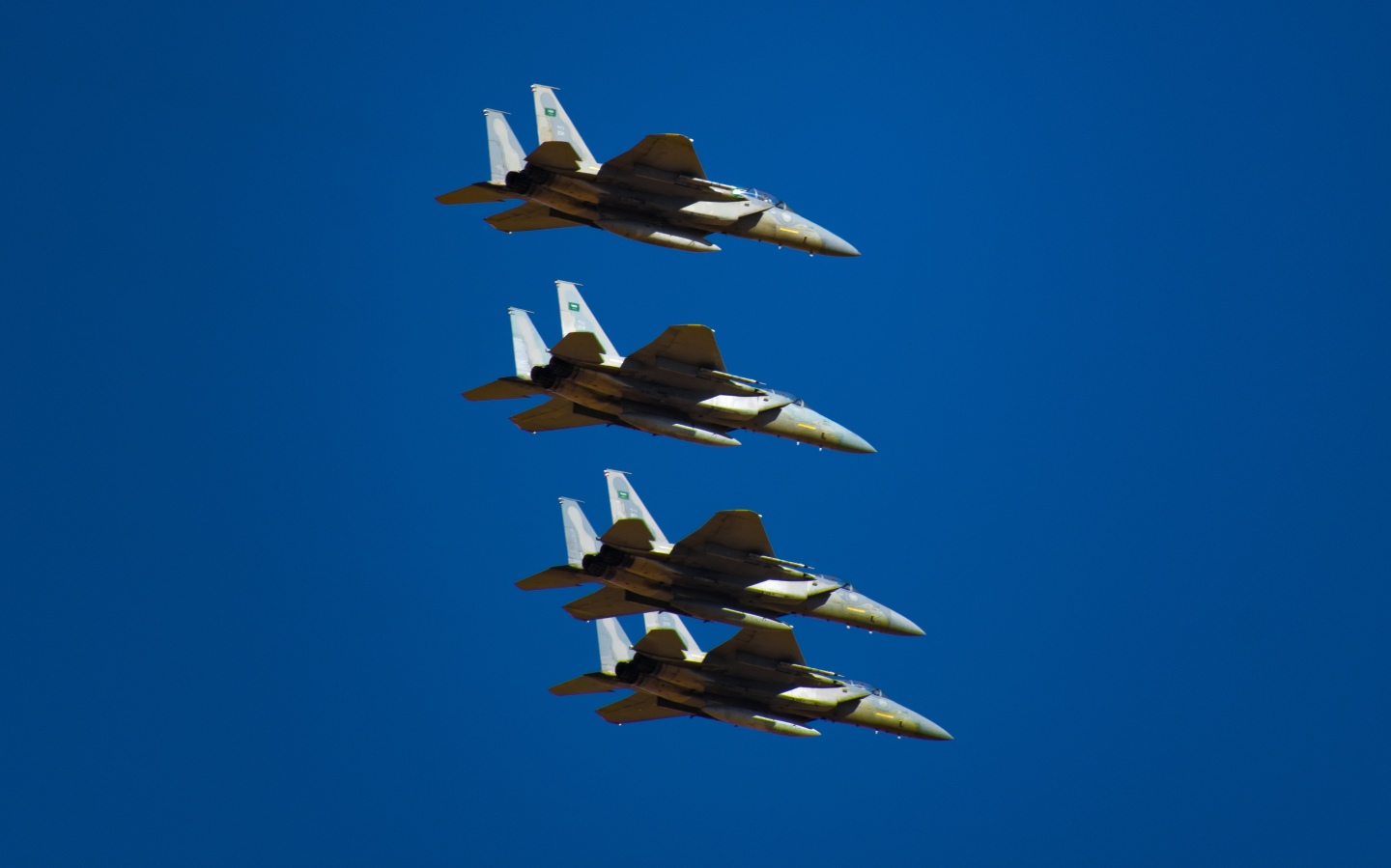In recent days reports have emerged that Saudi Arabia, along with the United Arab Emirates, was on the brink of launching an invasion of Qatar during the height of the crisis between the regional powers last summer. These reports suggest that former U.S. Secretary of State Rex Tillerson may have intervened diplomatically to prevent the conflict in a move that would eventually see him removed from his post. In this piece, former British Army Intelligence Officer Lewis Tallon examines what a conflict in Qatar might have looked like, and the wider risks it may have carried.
For an in-depth, bespoke briefing on this or any other geopolitical topic, consider Encylopedia Geopolitica’s intelligence consulting services.
In the early hours of the morning the first hostile jets entered Qatari airspace. Within minutes, Saudi F-15 strike fighters from King Abdulaziz air base in Eastern Province had traversed less than 100 kilometres to their targets and begun conducting strike operations on key command and control nodes around Doha and the neck of the peninsula. Several minutes later, Emirati aircraft from Al Dhafra air base in Abu Dhabi joined the battle, peppering the runways at Hamad International Airport with cluster munitions, sending vast swathes of travellers scrambling for cover inside the concourse of the massive transport hub. During the strike on the airport, a Turkish airways A330 is accidentally destroyed along with several Qatar Airways passenger jets.
Despite being pre-warned of the attack by Qatari intelligence agents in Riyadh, in the opening moments of the wider bombardment Qatari radar and U.S.-built Patriot PAC-3 air defence installations are reduced to rubble without firing a single shot; a victim of reaction times shortened by the tiny buffer of airspace surrounding them. A handful of French-built Roland 2 air-defence vehicles survive, later downing a French-built Mirage 2000 jet of the UAE air force. The only radar systems left operational on the peninsula are those of the 10,000-strong U.S. force at Al Udeid air base, whose control room quickly falls into a state of chaos as nervous watch officers witness three close allies go to war. Along the Qatar-Saudi border, 62 Leopard tanks of the Qatar Emiri Land Force begin firing on their Saudi counterparts in the Saudi town of Salwa from pre-prepared fighting positions around the Qatari As-Salwa military base, but are quickly neutralised by Riyadh’s AH-64 gunships. While most of Qatar’s Multiple Launch Rocket Systems (MLRS) are picked off by Saudi-UAE air assets in the opening blows of the conflict, several Brazillian-made Astros II, Soviet-era Grad MLRS platforms and German-made self-propelled guns escape detection, launching devastating counter-salvos into the Saudi military base at Salwa. Under the barrage of rockets, Saudi, Egyptian and Emirati troops begin advancing towards Doha, marching a path well clear of the U.S. garrison at Al Udeid. Less accurate artillery fire is directed at the Advancing Saudi-coalition forces, suffering from the collapsing Qatari front lines and a lack of surviving ground-based forward-observers and UAV ISTAR capabilities lost along with the country’s military command and control infrastructure.
Fifteen miles outside of Doha, at an abandoned British military base, two battalions of Turkish soldiers mobilise with orders from Ankara to assist the overwhelmed Qatari military. In Turkey, the air force scrambles to mobilise what long-range strike assets it can muster between the demands of its Syrian campaign and a brutal pilot shortage left in the wake of the post-coup purges. As the first Turkish military vehicles are destroyed by Emirati attack helicopters in the desert south of Doha – an easy target due to their lack of air cover – President Recep Tayyip Erdoğan calls on President Donald Trump in Washington. NATO’s Article V call for aid is invoked for the second time in the alliance’s history (the first having been in the wake of the 9/11 attacks), and the United States must now decide; reject Turkey’s call and risk dooming the NATO project, or go to war with two of Washington’s closest Gulf Allies.
The events above thankfully did not come to pass, however recent reports indicate that Saudi Arabia came close to launching an invasion of Qatar during the still-ongoing diplomatic crisis at the heart of the Gulf Cooperation Council (GCC) last summer. A direct confrontation between the Gulf powers would likely have seen a short but deadly conventional conflict – in part due to the massive arsenals of cutting-edge Western military hardware on both sides – and would have opened the door to another prolonged insurgency on the Arabian peninsula that Iran could leverage to bog Saudi Arabia down in yet another military quagmire. The crisis has seen several attempts at mediation, including laudable efforts by Kuwait and Oman, however the most effective peacemaking may have come from an unexpected source; the Trump Administration’s former Secretary of State and Oil Industry executive Rex Tillerson.
Although on the surface, Tillerson is reported to have been removed from his post following disagreements with the Administration over the U.S. response to the apparent Russian use of nerve agents in an assassination in the United Kingdom, a deeper source of opposition to his role at State may have also come from Riyadh and Abu Dhabi. Emails obtained by the BBC in March 2018 show that Major Trump fundraiser and UAE-linked businessman Elliott Broidy met with the President in late 2017 and pressured him to remove Tillerson from office. Other reports have suggested that the two Gulf powers were becoming increasingly frustrated by Tillerson’s efforts to mediate the crisis and end the blockade of Qatar; other reports have even suggested that the UAE’s ambassador to Washington was aware of Tillerson’s impending replacement with Mike Pompeo as early as three months ahead of his firing. A report issued by The Intercept this week links these efforts to remove Tillerson with his intervention to stop a conflict in the region, supposedly launched after a tip to the State Department from Qatari Intelligence agents who had gained knowledge of the impending invasion. State Department reports from last June indicated that Tillerson had held as many as 20 calls and meetings with various regional leaders in his efforts to de-escalate the crisis.
Around the same time that Qatari agents became aware of the impending invasion, Crown Prince Mohammed bin Salman ascended to become the de facto ruler of Saudi Arabia, bringing with him a significantly more assertive foreign policy platform. While the desert of the GCC crisis has since remained unmoved, the dunes of regional politics have continued to shift; Bin Salman has reorganised Riyadh’s political scene, curtailing the power of Saudi Arabia’s religious establishment, decimating his potential opponents within the House of Saud, and bringing the nation back into a closer U.S. foreign policy orbit from the cooler periods of the Obama administration. This renewed relationship likely assisted Riyadh greatly in its joint efforts with Abu Dhabi to pressure Trump to replace Tillerson.
While Trump himself has spoken in support of the blockade of Qatar, the presence of the U.S. CENTCOM forward command at Al Udeid, along with NATO-member forces from Turkey in the country, mean that an open conflict in Qatar would carry extraordinary risks far beyond the Gulf peninsula. The confusing chart of alliances across the region, as explored recently in terms of the risks accompanying outright multi-state conflict in Syria, could have sent destabilising ripples around the globe. Should Turkey have become embroiled in the conflict – and recent efforts to shore up its military presence in Qatar suggest a very real risk of this – NATO could have found itself being dragged into the conflict despite maintaining sound relations and close alliances with all involved parties. This could carry potentially destabilising risks to NATO, especially in the event of a U.S. refusal to respond to an Article V invocation. While Article V, contrary to popular belief does not necessarily require an armed response – instead requiring anything from nuclear war through to diplomatic protest as defined by “such action as it deems necessary” in response to collective security – a failure to swiftly and appropriately resolve a kinetic conflict involving a member state would vastly undermine the organisation’s credibility.
Iran would also almost certainly relish an opportunity to lodge another thorn in Saudi Arabia’s side on the Gulf’s southern shores. Frequent reports have emerged of Iranian efforts to arm and support Shi’a opposition forces in Bahrain against the Saudi-led Peninsula Shield forces, and Tehran has drawn Doha closer into its orbit throughout the GCC crisis. Although Qatar is a majority Sunni nation unlike Bahrain, Iran’s experienced Quds Force would still likely be able to find viable proxies to support in the event of a conflict with Saudi Arabia. Should Iran join the fray, the cross-Gulf scope of a conflict in Qatar would likely send global oil prices skyrocketing, which in turn would even reduce the sanctions-induced pressure on the hydrocarbon-dependent finances of Russia and in the long term could lead to a reversal of Moscow’s recent decision to reduce defence expenditure. Outright war between Iran and Saudi Arabia, although unlikely given the former’s preference for proxy-war operations, would also likely have been existentially dangerous for Riyadh. With both powers squaring off on all four compass points from Riyadh; in Yemen, Syria, Bahrain, in the Horn of Africa and even as far afield as Western Sahara, such a conflict would affect both the Hormuz and Bab al Mandeb maritime choke-points.
Although Tillerson remains a questionable choice for Secretary of State due to the lasting damage done to the Department under his patronage, it cannot be denied that his swan-song act of mediation in Qatar may have saved not only the tiny peninsula nation, but NATO itself. The question now remains whether the more hawkish replacements in the ever-changing lineup of the Trump Administration will continue to recognise these risks as the crisis continues to drag on.
Suggested books for in-depth reading on this topic:
Purchases made using the links in this article earn referrals for Encyclopedia Geopolitica. As an independent publication, our writers are volunteers from within the professional geopolitical intelligence community, and referrals like this support future articles.
- The Gulf Cooperation Council States: Hereditary Succession, Oil and Foreign Powers (Yousef Khalifa Al-Yousef)
- Troubled Waters: Insecurity in the Persian Gulf (Mehran Kamrava)
- Saudi Arabian Foreign Policy: Conflict and Cooperation in Uncertain Times (Neil Partrick)
- The UAE and Saudi Arabia: Border Disputes and International Relations in the Gulf (Noura Saber Al-Mazrouei)
- Saudi Arabia & Iran: Power and Rivalry in the Middle East (Simon Mabon)
Encyclopedia Geopolitica readers can also benefit from a free trial of Kindle Unlimited, which offers unlimited reading from over 1 million ebooks and thousands of audiobooks.
Lewis Tallon is a former British Army Intelligence Officer with several years experience working and living in the Middle East and North Africa region and Asia Pacific in geopolitical, armed conflict risk and threat intelligence roles. Lewis currently specialises in providing MENA-region geopolitical intelligence support to the oil & gas industry, and the financial sector.
For an in-depth, bespoke briefing on this or any other geopolitical topic, consider Encylopedia Geopolitica’s intelligence consulting services.
Photo credit: Meteb Ali

